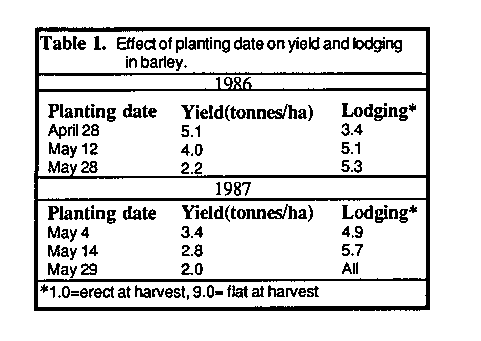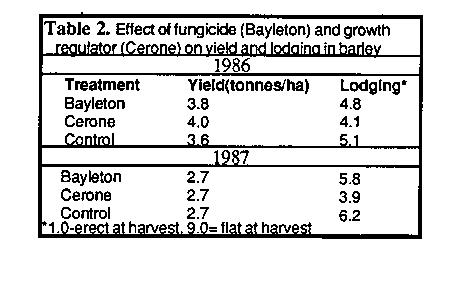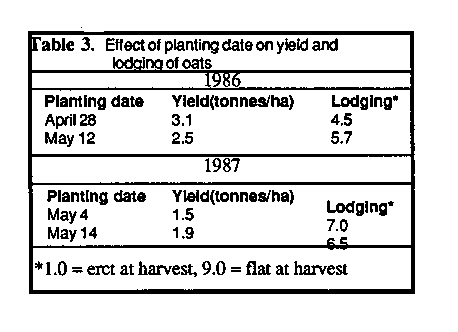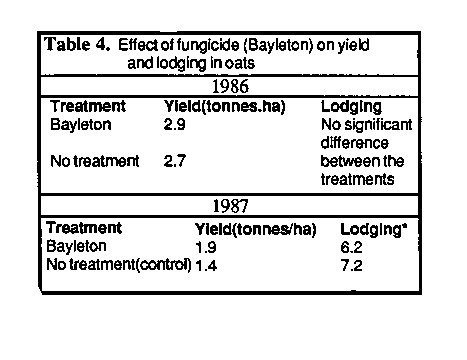
Sustainable Farming Index | Virtual Library | Magazine Rack
Search
| Ecological Solutions Roundtable
Since the introduction of plant growth regulators (PGR) and fungicides into Canada, traditional field husbandry methods are being questioned. If a growth regulator can keep a crop standing, there is temptation to increase nitrogen fertility and seeding rates in the hope of increasing yield. If fungicides can effectively combat foliar diseases, one might consider growing a cultivar lacking resistance but possessing high yield potential.
Two recommended varieties of barley and oats (foundation seed) were sown at deferent planting dates at the Winchester Agronomy Research Station. A fungicide (Bayleton) and a PGR (Cerone) were applied. Different nitrogen fertility levels and varying seed rates were also tested under both abnormal and Intensive management conditions.
Cereal producers have always known that early seeding leads to high yields. My results, are no exception. In both 1986 and 1987, yields were highest at the earliest seeding (Table 1). The fact that lodging gets worse as planting is delayed is not as well known. It is clear, however, that our early planting stood better than later ones both years.

In 1986 the use of a fungicide caused a significant increase in yield compared to the control (Table 2).

1986 was a wet year, conducive to powdery mildew growth on the crop. Plots sprayed with Bayleton developed only 10 % of the mildew in the control plots which were not sprayed. This reduction in mildew undoubtedly caused the yield to increase. But 1987 was different. Little mildew developed thanks to less moisture throughout the growing season. Not surprisingly, yield was not increased due to the use of Bayleton (Table 2).
An economic analysis of fungicide use is not yet completed in barley. The data in Table 2, however, suggests fungicides to control powdery mildew may be warranted for years in which the disease is expected to be prevalent.
In both years, the PGR reduced lodging (Table 2). Statistical analysis has shown that in 1987 the PGR worked better for late plantings to reduce lodging compared to non-sprayed plots control plots). In other words, the effect of the PGR to reduce lodging is best when planting is late.
Recall in Table 1 that late planted barley lodged more than earlier seedlings. Late plantings, with their inherently higher risk of lodging, would benefit most from the use of the Cerone treatment.
Our testing showed that cultivars varied in susceptibility to lodging. It follows that a strongstrawed cultivar planted early will not need a growth regulator most years. A weaker variety planted late, will.
In 1986, the early seeding yielded more than the later one (Table 3). This result is similar to the barley experiment. I was surprised to discover that this pattern did not occur in 1987. Upon examination of disease and lodging notes, I noticed that septoria (not controlled by Bayleton) was exceptionally severe in 1987. Among other negative attributes, Septoria in advanced stages causes stem breakage. In a season when septoria is severe, early seeding are more prone to stem breakage than later ones. Thus the lodging score is higher for the earlier seeding in 1987 (Table 3). This high lodging rate caused field losses at harvest. This would account for the lower yield with the earlier seeded plot.
Lodninn scores in 1986 were as could normally be expected and was worse in later-seeded plots.
Fungicide use increased yield significantly both years (Table 4). In 1986, OAC Woodstock showed resistance to crown nust while Donald was susceptible. In 1986, the yield increase due to fungicide can be attributed to yield increases for Donald. The rust fungus became virulent on OAC Woodstock in 1987. Our data shows Bayleton was effective in reducing rust and increasing yield on both cultivars in that year.
It appears from our trials that fungicide and/or PGR use is not warranted under all possible growing conditions. A disease resistant variety planted early may not need help from these chemicals. In lower yielding situations like. late planting, or lack of straw strength or disease tolerance in a cultivar, proper use of a PGR or fungicide will rehabilitate the crop to some extent.
Since yields of crops vary markedly depending on the field conditions which occurred during the production of the seed, seed harvested from this experiment will be tested both in laboratory and field to evaluate the effect of our different treatments on a subsequent grain crop. Also to be further evaluated at KCAT are the economic advantages of other intensive management inputs.


Reprinted with permission from A.I.S. Communication from Agri Book Magazine Vol 114(3) January 1988
Copyright © 1988 REAP Canada
Reprinted with permission. All rights reserved.
Info Request | Services | Become EAP Member | Site Map
Give us your comments about the EAP site
Ecological Agriculture Projects, McGill University (Macdonald
Campus),
Ste-Anne-de-Bellevue, QC, H9X 3V9 Canada
Telephone:
(514)-398-7771
Fax:
(514)-398-7621
Email: info@eap.mcgill.ca
To report problems or otherwise comment on the structure of this site, send mail to the Webmaster